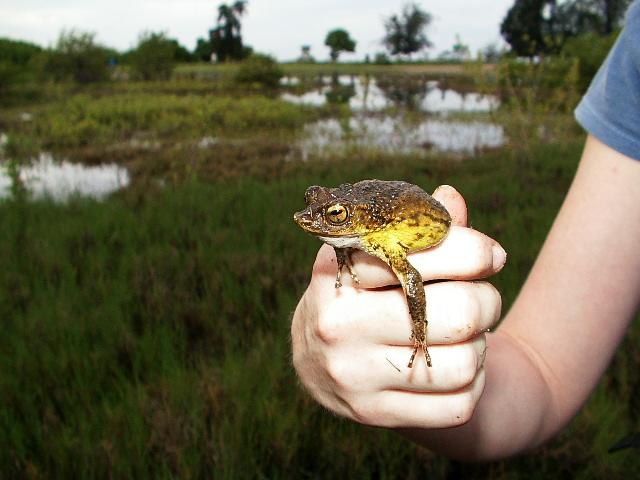| 댓글 |
|
| | 손님 |
|
 |
PUERTO RICAN CRESTED TOAD
(Peltophryne lemur)
FAMILY: Bufonidae
STATUS: Threatened, Federal Register, August 4, 1987
DESCRIPTION: The Puerto Rican crested toad is a medium-sized toad, 64 to 12O millimeters (2.5 to 4.5 inches) in snout-vent length, yellowish-olive to blackish-brown in color, with prominent supraorbital crests and a distinctive long, upturned snout. Males are considerably smaller than females, and exhibit less prominent crests. No studies have been conducted on the Puerto Rican crested toad's feeding habits, but as a general rule toads are opportunistic feeders that primarily consume insects and other invertebrates.
REPRODUCTION AND DEVELOPMENT: Although not completely understood, breeding appears to be sporadic and highly dependent upon occasional heavy rains (Rivero et al., 198O, Moreno 1985). When rainfall and surface water are adequate, more than one breeding event may occur in a single season. Breeding is concentrated in a very short period, and within a few weeks the toadlets metamorphose and quickly disperse. There is a high fidelity in breeding sites that offer the right combination of elevation, topography, and ponded fresh water.
RANGE AND POPULATION LEVEL: This toad is presently known to exist only on the main island of Puerto Rico. A single large population is known from the southwest coast in the Guanica Commonwealth Forest, and a small population is believed to survive on the north coast. It has also been collected on the southern coastal plain near Coamo. Northern coastal plain collections have been made near Isabela, Quebradillas, Arecibo, Barceloneta, Vega Baja, and Bayamon. The species has also been propagated in captivity (Paine 1985) and approximately 850 toadlets were released in Cambalache Commonwealth Forest on the north coast in 1984 and 1985. To date, over 4,OOO toadlets have been produced in captivity at the Metro Toronto Zoo and returned to Puerto Rico.
Historically, the Puerto Rican crested toad has been collected on the island of Virgin Gorda in the British Virgin Islands. The known historic distribution on Virgin Gorda is very limited and the species has not been observed there for at least 2 decades. It is assumed to have been extirpated from that island. Exact numbers are unknown. The Guanica Commonwealth Forest population is relatively stable and consists of approximately 1,5OO to 2,OOO individuals. The northern population consists of approximately 25 individuals. Nothing is known about population numbers in other localities, especially since the species is very difficult to encounter on a periodic basis.
HABITAT: The Puerto Rican crested toad occurs at low elevations (below 2OO meters or 66O feet) where there is exposed limestone or porous, well-drained soil offering an abundance of fissures and cavities. Adult toads are semifossorial and widely dispersed when not breeding. Because of this cryptic behavior, the location or even presence of adult toads when not breeding is difficult to detect.
REASONS FOR CURRENT STATUS: Loss of habitat from filling and drainage of breeding sites, and direct loss of adults and their habitat during land development are considered the primary factors for the toad's present status. Although the Puerto Rican crested toad has historically been rare, the species has undoubtedly declined further as its coastal lowland habitat has been destroyed by agricultural and urban development. In particular, known breeding sites have been filled or drained for construction, cultivation, and mosquito control. Construction projects are currently proposed which could affect the toad's status in the Guanica Commonwealth Forest area; however, discussions are continuing in an effort to find alternatives that will avoid destruction of toad breeding habitat.
Secondary factors may also be affecting the species' status. Predation on dispersing toadlets may be heavy, particularly from wading birds (M. Canals, Guanica Commonwealth Forest, personal communication.), and could become a significant factor if populations are greatly reduced by other problems. Additionally, reproduction in this species appears to rely on climatic events, sometimes one or more years apart, that occur at irregular intervals. Such reliance may create natural fluctuations in population sizes that could, when compounded by a reduced availability of breeding sites, increase the likelihood of whole subpopulations being eliminated. Extremes in sex ratios have also been reported; a low incidence of males in one area (Rivero et al., 1980), and a low incidence of females at another locality (Moreno 1985). However, the significance of these observations is difficult to assess without more information about the reproductive biology of this species.
MANAGEMENT AND PROTECTION: Protection of habitat is considered the highest priority need. Limited numbers of breeding sites are apparently used by toads from a large surrounding area. In one case, a marked and recaptured female traveled 4 linear kilometers (Moreno 1985). The conservation of whole subpopulations may be dependent on the identification and protection of these sites. Additional surveys are needed to better determine the species' distributions and abundance. Should reintroduction be necessary, captive breeding has been successfully accomplished in the past and could be used again to provide individuals for this purpose. |
|
|
